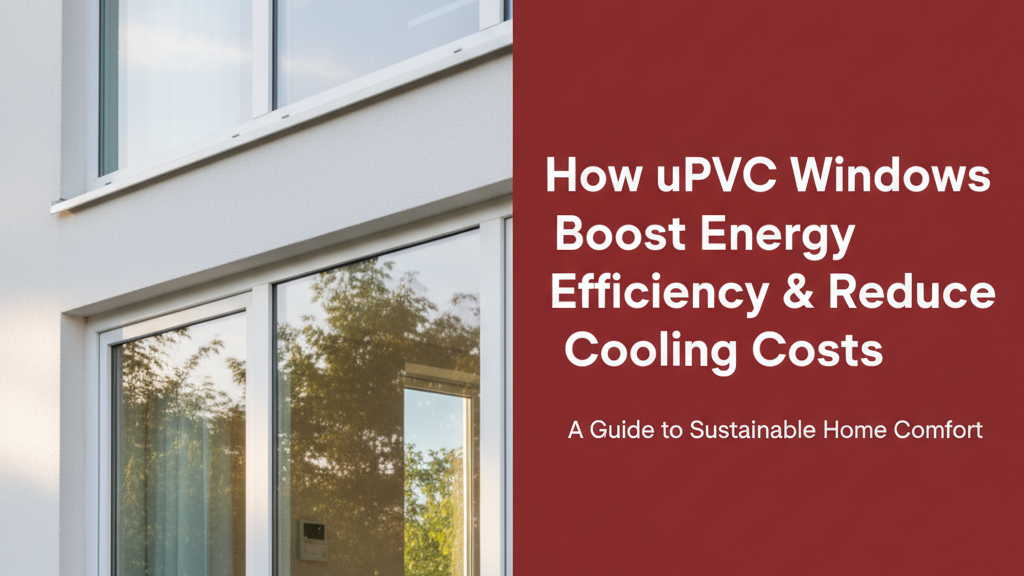The Rising Importance of Energy-Efficient Windows
With rising temperatures and increasing electricity costs across India, homeowners are prioritising solutions that improve thermal comfort while reducing cooling expenses. Windows, often accounting for 25–30% of a building’s heat gain, play a pivotal role in this equation. uPVC windows have emerged as a scientifically validated solution, blending thermal insulation, structural stability, and cost-effectiveness for Indian conditions.
What Makes uPVC Windows So Energy Efficient?
uPVC (unplasticised polyvinyl chloride) windows offer inherent advantages over traditional materials:
- Low thermal conductivity: uPVC conducts heat 1,000 times slower than aluminium, minimising heat transfer between indoors and outdoors.
- Air-tight seals: Precision-engineered gaskets reduce air infiltration by 70–80% compared to conventional wooden frames.
- Moisture resistance: Unlike wood, uPVC doesn’t warp in humidity, maintaining consistent sealing performance during monsoons.
How uPVC Windows Compare to Other Materials
| Material | Thermal Conductivity (W/m·K) | Air Leakage Potential | Maintenance Needs |
|---|---|---|---|
| uPVC | 0.16–0.22 | Low | Virtually none |
| Aluminium | 160–210 | Moderate to high | Annual sealing checks |
| Wood | 0.13–0.18 | High (if warped) | Seasonal repainting |
Note: Thermal conductivity values sourced from BIS standards for building materials.
Key Features of uPVC Windows That Enhance Energy Efficiency
Multi-Chambered Design for Superior Insulation
Quality uPVC profiles feature 4–7 internal chambers that:
- Create air pockets acting as thermal barriers
- Improve structural rigidity without metal reinforcements
- Reduce condensation risks by separating indoor/outdoor air flows
Thermal Break Technology Explained
For aluminium-clad uPVC windows, thermal breaks involve:
- A polyamide strip isolating exterior and interior metal components
- Up to 60% reduction in conducted heat compared to standard aluminium frames
The Role of Double or Triple Glazing
When paired with uPVC frames, advanced glazing enhances performance:
- Double glazing: 6–12mm argon-filled gaps provide U-values of 1.1–1.3 W/m²K
- Triple glazing: Two low-E coatings can achieve U-values below 0.8 W/m²K
How uPVC Windows Help Reduce Cooling Costs
Blocking Heat Transfer Effectively
Field tests across Indian cities demonstrate:
- Interior temperatures 4–7°C lower than rooms with single-glazed aluminium windows
- Delayed heat penetration by 3–5 hours during peak afternoon temperatures
Lowering Dependence on Air Conditioning
The combined effect of uPVC systems can:
- Reduce AC runtime by 25–40% in moderate climates
- Cut overall cooling energy consumption by 15–30% annually
The Long-Term Savings: Calculating Your ROI
A typical 3BHK home replacing aluminium windows might see:
- Initial investment: ₹90,000–₹1,20,000
- Annual electricity savings: ₹8,000–₹12,000
- Payback period: 8–12 years with zero maintenance costs
Additional Benefits of uPVC Windows Beyond Energy Savings
- 50+ year lifespan: UV-stabilised formulations prevent fading or brittleness
- Noise reduction: Multi-chamber designs attenuate 35–42 dB of street noise
- Enhanced security: Steel-reinforced meeting stiles resist forced entry
- Dust mitigation: Superior sealing reduces particulate infiltration by 60–75%
Choosing the Right uPVC Windows for Maximum Efficiency
For optimal performance in Indian conditions:
- Select profiles with ≥5 chambers and wall thicknesses >2.5mm
- Verify BIS/ISI markings on both uPVC profiles and hardware
- Prioritise full-frame installations over retrofit options
- Consider spectrally selective glass coatings for west-facing windows
Why uPVC Is the Smart Choice for Energy-Conscious Homeowners
Beyond immediate cooling cost reductions, uPVC windows offer scientifically validated thermal performance that becomes increasingly valuable as energy costs rise. Their maintenance-free operation and durability make them particularly suited for India’s diverse climatic challenges, from coastal humidity to desert heat.


